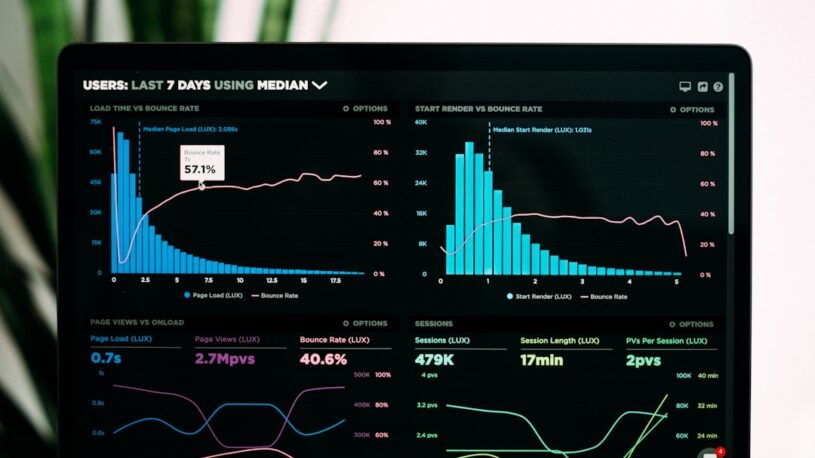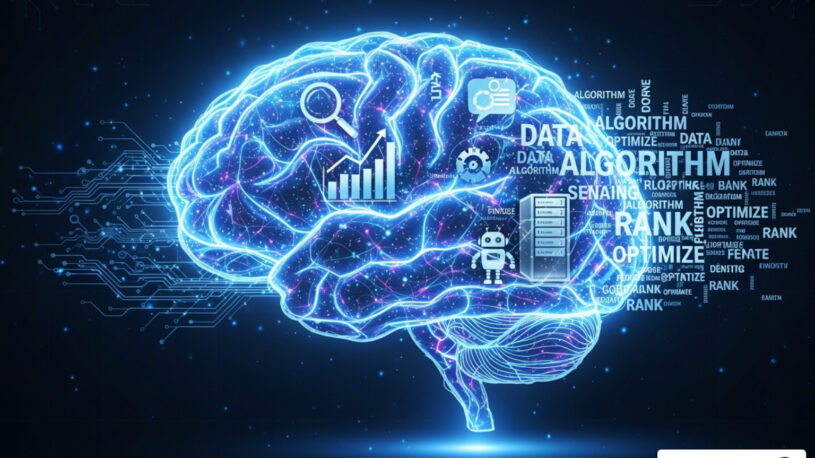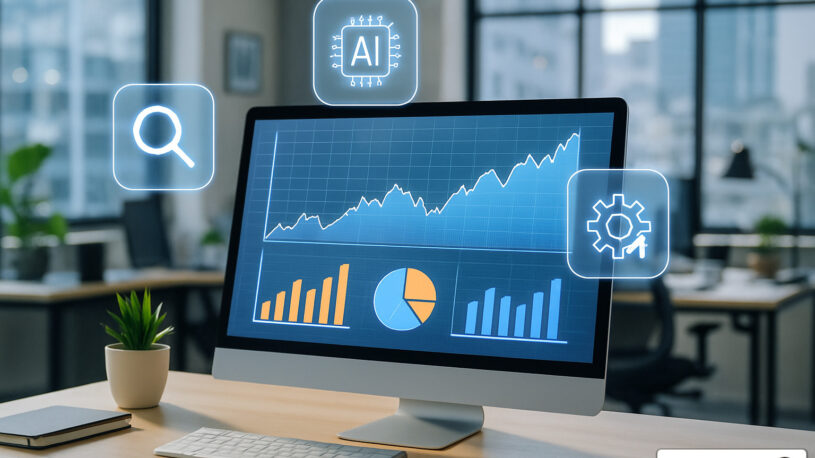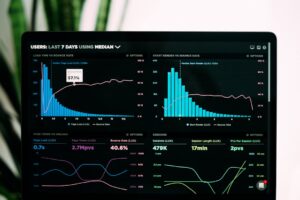

AI-Powered Business Insights: Because Gut Feelings Aren’t Data
Navigating the Data Revolution with AI
Welcome to the age of information abundance! I’m Randy Bryan, founder of tekRESCUE, and I’ve helped businesses transform their mountains of data into goldmines of insight. Let me guide you through the exciting world of using AI for business analytics.
Think of AI for business analytics as your company’s secret decoder ring for all that data you’ve been collecting. It’s not just about gathering numbers anymore—it’s about understanding what they mean and using them to make brilliant decisions.
At its core, AI for business analytics uses artificial intelligence to analyze your business data, spot patterns human eyes might miss, predict what’s coming next, and suggest smart actions you can take right away. The results speak for themselves: businesses experience 5x faster productivity growth, can make sense of over 400 different data sources, and often see conversion rates jump by 30%.
We’re truly living in the Fourth Industrial Revolution, where data flows like a mighty river through every business. The challenge isn’t getting data—it’s making sense of it all! While traditional analytics might tell you what happened yesterday, AI for business analytics explains why it happened, predicts what’s coming tomorrow, and recommends exactly what you should do about it.
“Business intelligence tends to have this notion of looking backwards. It’s not thinking about prescriptive or predictive analytics, or live analytics.” – Scott Stevens, Executive Director of Global Technology at JPMorgan Chase
The days of making major business decisions based solely on gut feelings are behind us. According to PwC research, industries that accept AI see productivity skyrocket nearly 5 times faster than those lagging behind. This isn’t just about prettier reports—it’s about fundamentally changing how your business operates.
The difference between thriving companies and struggling ones often comes down to one thing: the ability to extract meaningful insights from data quickly. Throughout this guide, I’ll show you exactly how to use AI to transform your data into your most valuable strategic asset.
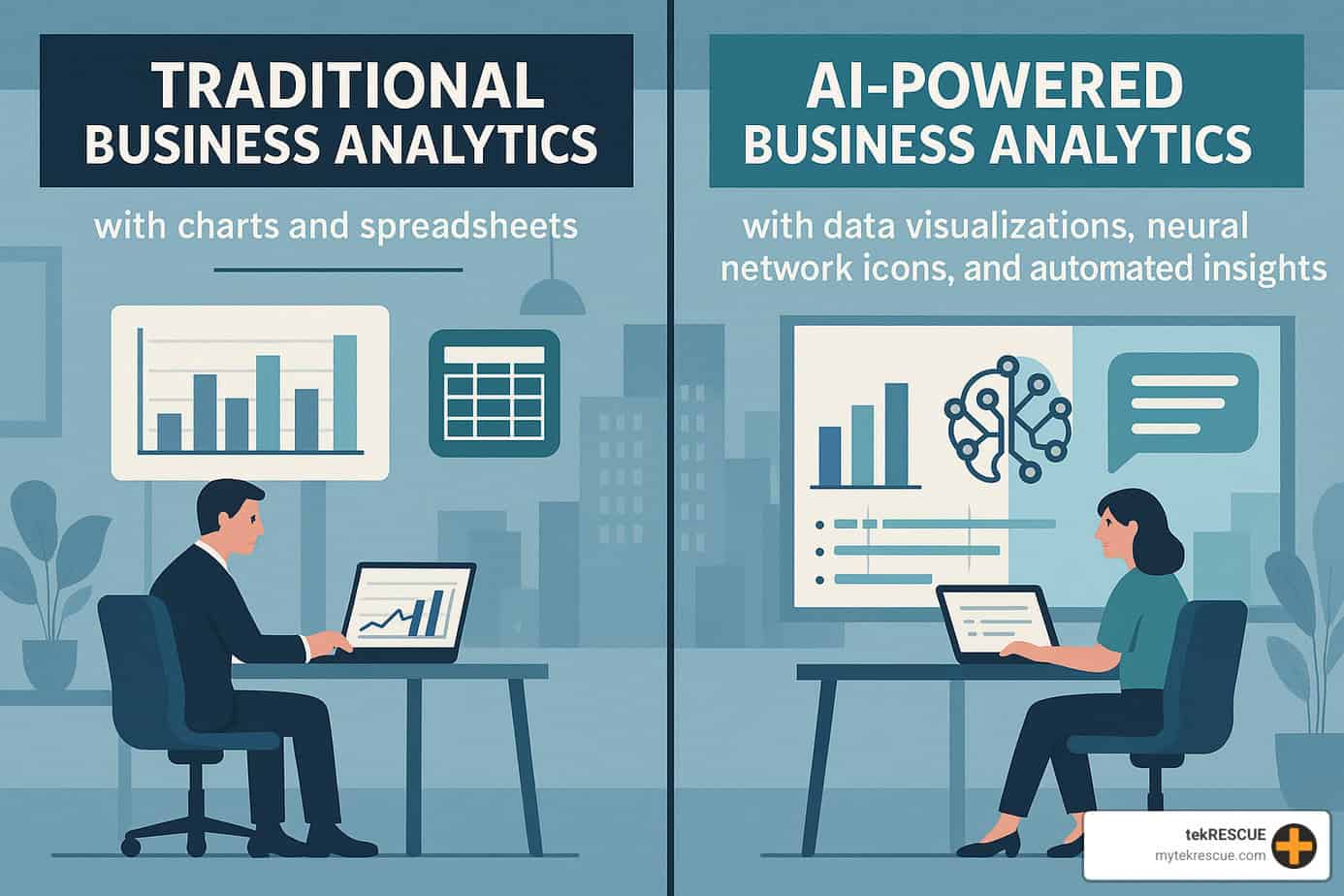
Why This Guide Matters
From small shops in San Marcos to corporate offices in Dallas-Fort Worth, I’ve seen how AI for business analytics delivers real, tangible value across Texas. The companies that accept this technology gain a serious edge over their competition.
What kind of edge? They make better strategic choices because they’re using AI-powered insights instead of hunches. They enjoy faster response times to market changes, often identifying shifts before competitors even notice them. They achieve resource optimization by putting their money and talent exactly where they’ll have the greatest impact. And perhaps most importantly, they benefit from risk reduction by spotting potential problems before they become expensive disasters.
Whether you run a retail store in New Braunfels trying to get your inventory just right, manage financial services in San Antonio looking to catch fraud before it happens, or operate a manufacturing plant in Central Texas aiming to streamline your supply chain, AI for business analytics provides the foundation for smarter, more confident business decisions.
The beauty of this technology is that it works for businesses of all sizes. You don’t need to be a tech giant to benefit—you just need the right partner to help you implement these powerful tools in ways that make sense for your specific needs.
AI for Business Analytics: Moving from Descriptive to Prescriptive
Remember when business analytics just meant looking backward? Those days of “What happened last quarter?” reports are rapidly becoming outdated. Traditional analytics required technical wizards to generate insights and typically only worked with neatly organized data in spreadsheets and databases.
AI for business analytics changes the game completely by breaking through four major limitations:
First, it handles both structured and unstructured data with ease. While traditional systems struggled with anything outside a database, AI comfortably extracts insights from emails, social posts, customer reviews, call transcripts, images, and more. This matters tremendously since 80-90% of new enterprise data is unstructured!
Second, through machine learning and neural networks, AI identifies subtle patterns across millions of data points and hundreds of variables that would be impossible for humans to detect manually.
Third, you get real-time processing instead of waiting for monthly reports. Imagine having continuous insights streaming in as data arrives, letting you respond to market shifts immediately.
Fourth, AI democratizes data access through natural language interfaces and automated visualizations, making insights available to everyone—not just your data team.
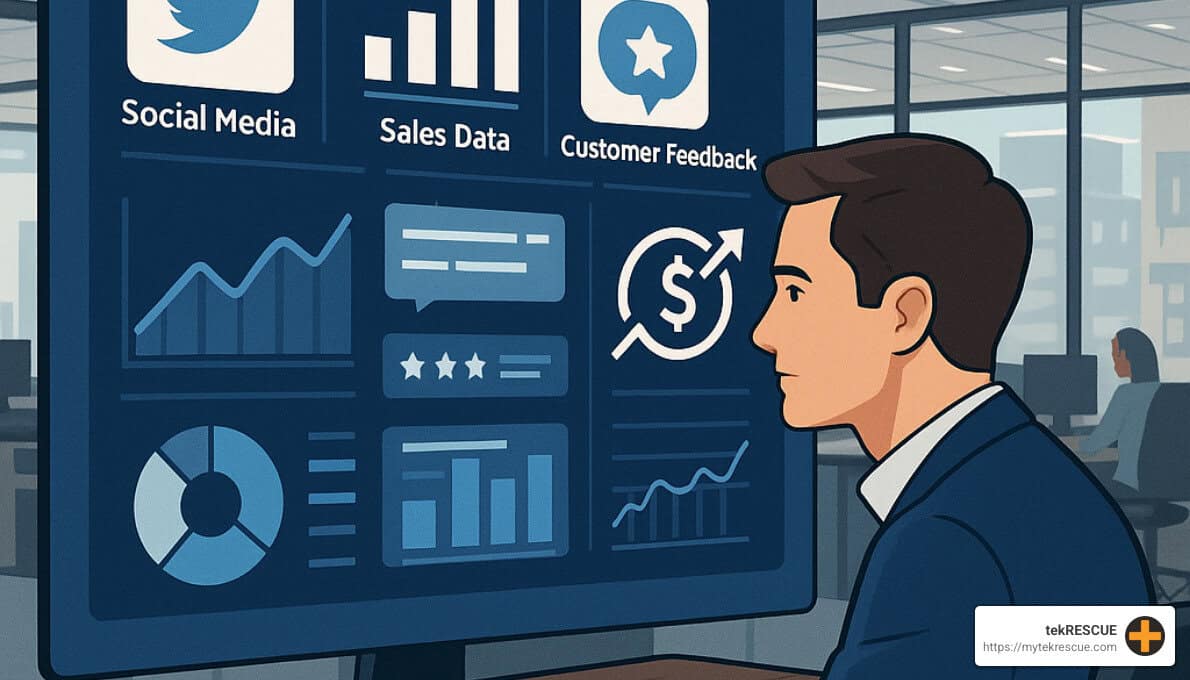
The difference between traditional and AI-powered analytics is stark:
| Aspect | Traditional Analytics | AI-Powered Analytics |
|---|---|---|
| Primary focus | What happened (descriptive) | Why it happened, what will happen, what to do (diagnostic, predictive, prescriptive) |
| Data types | Primarily structured | Both structured and unstructured |
| Analysis speed | Hours to weeks | Seconds to minutes |
| User expertise required | Technical analysts | Any business user (with proper tools) |
| Insight generation | Manual | Automated with human oversight |
| Scalability | Limited by human capacity | Virtually unlimited |
| Decision support | Provides information | Recommends actions |
| Learning capability | Static models | Continuously improving models |
According to McKinsey’s research on data-driven enterprises, organizations fully leveraging AI can slash the time from data collection to insight by up to 90%. That’s the difference between responding to a market change in three weeks versus responding the same day!
What Sets AI-Powered Analytics Apart?
Four game-changing capabilities make AI for business analytics truly revolutionary:
1. Self-Service Analytics
Remember having to beg your data team for a new dashboard? Those days are gone. Now anyone in your organization can simply ask questions in plain English like “Which marketing channel had the highest conversion rate last month?” and instantly receive visualizations and insights.
This democratization matters tremendously because it frees your data scientists from report-running duties. Industry research shows a shocking 92% of data workers spend most of their time on operational tasks rather than strategic analysis. AI flips this equation, letting your analysts do what you actually hired them for.
2. Conversational Interfaces
Modern AI for business analytics platforms feel like talking to a helpful colleague. Natural language processing lets users ask follow-up questions, drill deeper into interesting findings, and receive explanations in plain language.
These systems don’t just answer your questions—they suggest questions you haven’t thought to ask. Plus, they deliver insights through familiar channels like Slack or Teams, meeting you where you already work.
3. Continuous Learning
Unlike traditional tools with static models, AI systems get smarter over time. They learn which insights matter most to different departments, make increasingly relevant recommendations, and adapt as your business evolves. They’re like employees who get better every day without asking for raises!
4. Anomaly Detection
AI has an uncanny ability to spot needles in haystacks—those subtle patterns that human analysts might miss. It automatically flags unusual transactions that could indicate fraud, detects early shifts in customer behavior that might signal emerging trends, and surfaces process inefficiencies before they hurt your bottom line.
Core Benefits Organizations Realize
When implemented thoughtfully, AI for business analytics delivers concrete benefits that impact your entire organization:
Speed-to-Insight
The most immediate benefit is dramatically faster analysis. Questions that once took weeks now resolve in seconds. Real-time dashboards update continuously as new data arrives, and automated alerts notify you when key metrics change significantly.
I recently worked with a retailer in Fort Worth who reduced their customer segmentation analysis time from two weeks to less than an hour. This allowed them to adjust marketing campaigns based on performance data almost immediately, rather than waiting until it was too late to matter.
Cost Savings
The efficiency gains from AI analytics touch multiple areas: smaller data teams, lower infrastructure costs through cloud deployment, fewer costly business mistakes due to improved forecasting, and smarter resource allocation.
One of our manufacturing clients in Central Texas cut inventory costs by 23% after implementing AI-powered demand forecasting. They eliminated excess stock while maintaining service levels—a win-win that went straight to their bottom line.
Risk Reduction
AI’s ability to process vast data makes it exceptionally good at spotting potential problems before they become crises. It can detect fraud attempts in real-time, identify cybersecurity threats through behavioral analysis, forecast cash flow issues before they impact operations, and highlight compliance risks in business processes.
Scalability
As your business grows, your analytics needs become more complex. AI-powered systems scale efficiently, processing more data without proportional cost increases, supporting larger user bases without performance degradation, and adapting to new business requirements without extensive reconfiguration.
Measurable Performance Improvements
The business impact of AI for business analytics is substantial and measurable. Case studies show businesses using AI-powered analytics seeing conversion rate improvements up to 30%. PwC research on productivity growth demonstrates that AI-intensive sectors experience productivity growth nearly 5x faster than less AI-focused industries. Organizations typically report 15-25% reductions in customer churn after implementing AI-driven personalization.
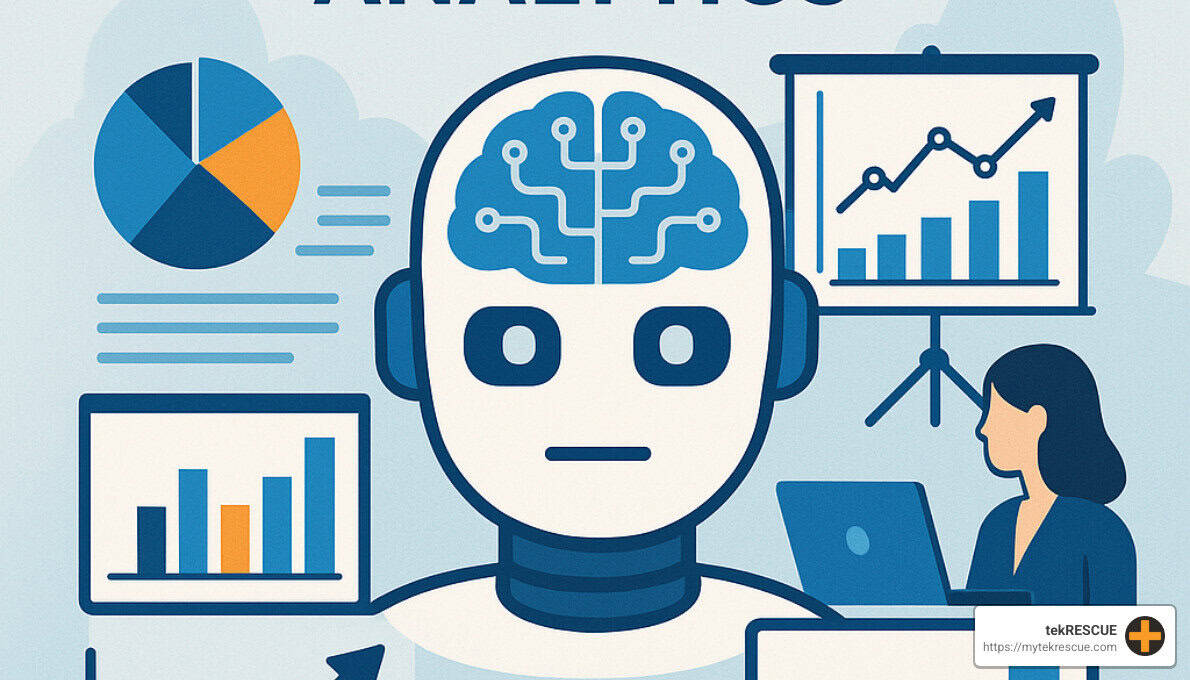
Predictive & Prescriptive Power: How AI for Business Analytics Drives Proactive Decisions
The real magic of AI for business analytics happens when we move beyond understanding the past to predicting and shaping the future:
Forecasting
AI models predict future outcomes with remarkable accuracy by analyzing historical data and identifying complex patterns. A financial services client in San Antonio improved their loan default prediction accuracy by 42% after implementing AI-powered risk assessment, allowing them to adjust lending criteria and dramatically reduce bad debt.
These forecasting capabilities extend to sales projections that account for seasonality and market trends, customer lifetime value predictions to guide retention strategies, demand forecasting to optimize inventory, and cash flow projections that prevent liquidity issues.
Scenario Modeling
AI enables you to answer “what if” questions with unprecedented sophistication. Want to know how a 5% price increase might affect demand across different customer segments? Or how shifting your marketing budget would impact ROI? AI can simulate these scenarios using your actual data, helping you make confident decisions before committing resources.
Decision Optimization
Beyond predicting outcomes, AI recommends optimal decisions by identifying the ideal product mix to maximize revenue, determining the most effective pricing strategy across market segments, suggesting customer engagement approaches based on behavioral data, and recommending resource allocations that maximize efficiency.
Root-Cause Analysis
When performance metrics change, AI quickly identifies why by analyzing thousands of variables to determine which factors most strongly correlate with observed changes. It distinguishes between correlation and causation, visualizes complex relationships intuitively, and explains findings in plain language.
Actionable Recommendations
Most importantly, modern AI for business analytics platforms don’t just provide insights—they recommend specific actions: “Increase inventory of Product X by 15% to meet projected holiday demand” or “Shift 20% of marketing budget from Channel A to Channel B based on conversion data.”
AI for Customer Personalization & Segmentation
One of the most powerful applications of AI for business analytics is changing how businesses understand and interact with customers:
Hyper-Personalization
AI enables personalization at a scale and depth previously impossible. A retail client in New Braunfels saw a 28% increase in average order value after implementing AI-powered product recommendations that considered not just purchase history but also browsing behavior, seasonal trends, and inventory availability.
The system analyzes thousands of customer attributes to identify preferences, generates individualized recommendations in real-time, personalizes pricing based on willingness-to-pay models, and tailors content to match communication preferences.
Sentiment Analysis
AI analyzes customer feedback across channels, automatically categorizing reviews by topic and sentiment, identifying emerging issues before they become widespread, tracking sentiment trends over time, and prioritizing customer service responses based on urgency and influence.
Natural Language Processing (NLP)
Advanced NLP capabilities extract insights from unstructured text by analyzing support tickets to identify common issues, mining social media for brand mentions, extracting competitive intelligence from news articles, and summarizing lengthy documents to highlight key information.
Micro-Segmentation
AI enables much more granular customer segmentation, creating hundreds or thousands of micro-segments based on behavior patterns, identifying niche market opportunities that broader approaches would miss, dynamically adjusting segments as customer behavior evolves, and targeting marketing with unprecedented precision.
Churn Prevention
AI excels at identifying customers at risk of leaving by detecting subtle behavioral changes that indicate decreasing engagement, predicting churn probability with high accuracy, recommending personalized retention strategies, and measuring the effectiveness of retention efforts in real-time.
For businesses looking to improve their processes beyond customer analytics, we offer specialized AI for Process Improvement services that apply similar techniques to internal operations.
Automating the Mundane: AI for Business Analytics Frees Analysts for Strategy
Perhaps the most underappreciated aspect of AI for business analytics is how it liberates human talent from routine tasks:
ETL Automation
Extract, Transform, Load (ETL) processes traditionally consume enormous amounts of analyst time. AI automates these tasks by identifying and extracting relevant data from diverse sources, cleaning and standardizing information without manual intervention, and detecting anomalies automatically.
A technology company in Dallas reduced their data preparation time by 85% after implementing AI-powered ETL automation. Their analysts now focus on strategic insights rather than data wrangling.
Report Generation
AI creates and distributes reports with minimal human involvement, automatically generating regular updates based on templates, highlighting significant changes, distributing insights to stakeholders through their preferred channels, and creating executive summaries focused on actionable information.
Data Cleansing
Data quality issues often consume disproportionate analyst time. AI helps by identifying duplicate records, standardizing formats, filling in missing values based on patterns, and flagging potentially erroneous data for review.
Human-in-the-Loop
Effective AI for business analytics doesn’t eliminate humans—it lifts them. Analysts focus on interpreting insights rather than generating them. Subject matter experts provide context that enriches AI-generated findings. Humans make final decisions based on AI recommendations. The combination of human intuition and AI processing yields superior results.
Upskilling
As AI automates routine analytics tasks, organizations must help their people develop new skills. Data literacy becomes essential for all business functions. Analysts need expertise in working with AI systems. Technical teams must learn to build and maintain AI models. Leaders need to understand how to incorporate AI insights into strategic planning.

Implementing AI-Powered Analytics: Tools, Use Cases & Best Practices
Taking the leap into AI for business analytics doesn’t have to feel overwhelming. With the right approach, businesses of all sizes can harness the power of AI to transform their data into actionable insights. Let’s walk through how to make this journey successful.
Think of implementing AI analytics like building a house—you need a solid foundation, the right tools, and a clear blueprint before you start constructing.
Implementation Roadmap
Most successful AI analytics journeys follow six key phases:
First, start with a thorough assessment of what you already have. Take stock of your current analytics capabilities, what data you’re collecting, and which business priorities need the most attention.
Next, develop a clear strategy with specific objectives. What problems are you trying to solve? What does success look like? Having these defined up front prevents the “shiny object syndrome” that derails many technology projects.
The technology selection phase comes third. Rather than jumping at the newest tool, choose solutions that align with your specific requirements and constraints. Sometimes the perfect solution isn’t the most complex one.
Always begin with a pilot project. Starting small with a high-value, manageable use case helps demonstrate value quickly and build momentum. Think of it as your proof of concept.
Once you’ve proven success, scale your implementation across the organization. This expansion should be methodical, not rushed.
Finally, commit to continuous optimization based on user feedback and measured results. The best AI implementations are never truly “finished”—they evolve as your business needs change.
Deployment Options
When it comes to deploying AI for business analytics, you have several paths to consider:
Cloud-based solutions offer the advantage of quick deployment and scalability without massive upfront infrastructure costs. They’re particularly well-suited for organizations that need to get up and running quickly.
For companies with stricter data security requirements, on-premises deployment provides maximum control over both data and infrastructure. This approach is often preferred in highly regulated industries.
Many businesses find that hybrid approaches offer the best of both worlds, combining cloud flexibility with on-premises security for sensitive data.
Don’t overlook no-code/low-code platforms that empower business users to create analytics applications with minimal technical expertise. These democratize access to AI capabilities across your organization.
Cross-Functional Teams
The most successful AI for business analytics implementations aren’t solely IT projects—they bring together diverse expertise:
Business stakeholders define what success looks like and ensure the solutions address real business problems. Their involvement from day one is crucial.
Data scientists design and validate the AI models that power your analytics. They’re the architects who ensure your insights are built on solid mathematical foundations.
IT professionals handle the technical integration and infrastructure needed to support your AI systems. They make sure everything works together smoothly.
Change management experts help drive adoption and address the natural resistance that comes with new ways of working. They’re essential for ensuring your investment actually gets used.
Legal and compliance teams address data privacy and regulatory considerations. Their early involvement prevents headaches down the road.
Governance
Good governance isn’t just red tape—it’s the framework that ensures your AI for business analytics initiative delivers sustainable value:
Effective data governance ensures your data remains accurate, secure, and compliant with regulations. Think of it as quality control for your most valuable asset.
Model governance involves validating and monitoring AI models for accuracy and potential bias. This ongoing oversight ensures your AI continues to deliver reliable insights.
Access governance controls who can see different insights and capabilities within your organization. This balances democratization with appropriate security.
Ethics governance ensures responsible use of AI and data. As AI becomes more powerful, ensuring it’s used ethically becomes increasingly important.
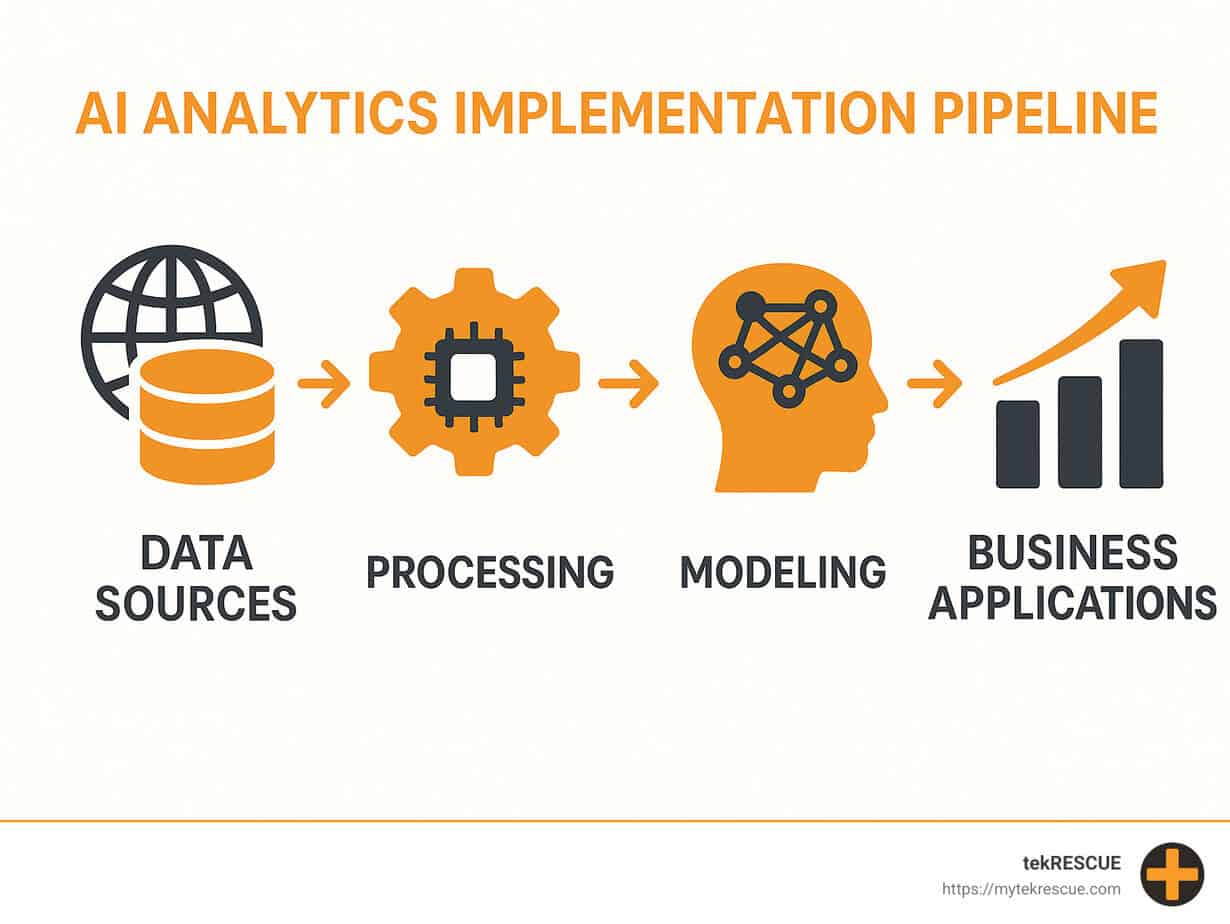
High-Value Use Cases Across Industries
The beauty of AI for business analytics is its versatility across virtually every industry. Here are some particularly powerful applications we’ve seen work well:
In the finance sector, AI excels at fraud detection by identifying unusual patterns that may indicate fraudulent activity. One financial institution we worked with in Texas reduced fraud losses by 62% after implementing AI-powered anomaly detection that spotted suspicious patterns across multiple transaction types in real-time.
For retail businesses, demand forecasting becomes dramatically more accurate with AI. A retailer in San Antonio increased sales by 18% after using AI analytics to optimize product placement based on purchase patterns and how customers actually moved through their stores.
Telecom companies leverage AI for network optimization and churn prediction, identifying customers likely to switch providers before they even start shopping around.
In manufacturing, quality control and predictive maintenance deliver immediate ROI. One manufacturer in Central Texas reduced unplanned downtime by 37% after implementing AI that could spot potential equipment failures days or weeks before they would occur.
For supply chain operations, inventory optimization and route planning become much more efficient with AI-powered insights guiding decisions.
And in healthcare, patient risk stratification and treatment optimization help improve outcomes while controlling costs.
Step-by-Step Implementation Roadmap
Let’s break down the implementation process into manageable steps:
1. Define KPIs and Business Objectives
Start by getting crystal clear about what success looks like. What specific business problems are you trying to solve? What metrics will tell you you’re succeeding? What kind of return on investment are you expecting? Who are your key stakeholders, and what do they need from this initiative?
I always tell clients: if you can’t explain what success looks like in a single sentence, you’re not ready to start implementing.
2. Conduct a Data Audit
You can’t make great decisions with poor data. Take time to assess what data you already collect, where it lives, how complete and accurate it is, and what additional data you might need. This is also the time to identify any data privacy or security concerns that need addressing.
One client finded during their audit that they were collecting valuable customer feedback data but never connecting it to their sales data—a missed opportunity that became a quick win once addressed.
3. Select Appropriate Tools
Choose your AI for business analytics tools based on your specific use cases and requirements, the technical capabilities of your team, how well they’ll integrate with your existing systems, their total cost of ownership, and their ability to scale as your needs grow.
The most expensive or complex tool isn’t always the right choice. Sometimes simpler solutions that your team can fully leverage deliver better results than sophisticated systems that remain partially implemented.
4. Launch Pilot Projects
Start small with high-impact use cases that have clear ROI potential. Set realistic timelines and expectations, ensure you have adequate resources and executive support, and establish clear success criteria.
A manufacturing client started with just one production line for their predictive maintenance pilot, proved the concept worked, then expanded across their facility.
5. Iterate and Improve
Adopt an agile approach to refining your implementation. Gather user feedback continuously, make incremental improvements, document lessons learned, and adjust your KPIs as needed.
This isn’t about getting everything perfect on the first try—it’s about learning and improving with each cycle.
6. Scale Successful Implementations
Once your pilots prove successful, develop a roadmap for broader deployment. Ensure your infrastructure can handle increased demands, create training programs for users, and establish centers of excellence to share best practices across departments.
Scaling too quickly can be as problematic as moving too slowly—find the pace that works for your organization.
7. Implement Change Management
The human side of implementation often determines success or failure. Communicate the benefits clearly to all stakeholders, provide comprehensive training and support, recognize and reward adoption and innovation, and address concerns and resistance proactively.
One client created “AI Champions” in each department who became internal advocates and go-to resources for their colleagues.
8. Secure Stakeholder Buy-In
Maintain executive and user support by regularly communicating successes and lessons learned, tying analytics initiatives to strategic business objectives, demonstrating clear ROI, and celebrating wins through success stories.
When people see how AI for business analytics makes their jobs easier or more impactful, adoption accelerates naturally.
Ensuring Data Quality, Ethics & Governance
Data Quality
The old saying “garbage in, garbage out” applies doubly to AI systems. Implement robust data validation and cleansing processes, establish data quality metrics and monitoring, create feedback loops to continuously improve data quality, and document data lineage and changes.
One financial services client found that improving their data quality actually delivered more value than the sophisticated AI models they initially wanted to implement.
Bias Mitigation
AI systems can inadvertently perpetuate or amplify biases present in training data. Audit your training data for potential biases, use diverse data sources and balanced training sets, test models with different demographic groups, and continuously monitor for biased outcomes.
This isn’t just an ethical concern—biased AI makes poor business decisions that can damage your brand and bottom line.
Privacy Considerations
Respecting privacy is both an ethical imperative and a legal requirement. Ensure compliance with relevant regulations (GDPR, CCPA, etc.), implement data anonymization where appropriate, obtain necessary consents for data use, and provide transparency about how data is used.
We’ve helped several clients implement “privacy by design” approaches that build protection into their analytics from the ground up.
Explainability
Users need to understand how AI reaches its conclusions for both practical and regulatory reasons. Choose models that provide interpretable results when possible, implement tools that explain AI decisions in plain language, document model inputs and decision criteria, and enable users to explore the factors influencing specific recommendations.
“Black box” AI may be powerful, but if people don’t trust the recommendations, they won’t act on them.
Compliance
Ensure your AI analytics adheres to relevant regulations by working with legal and compliance teams from the beginning, documenting decision-making processes for audit purposes, staying current with evolving regulations, and considering frameworks like the AI Bill of Rights which emphasizes safe systems, discrimination protections, data privacy, and transparency.
Measuring ROI & Building AI Talent
Value Metrics
Measure the impact of your AI for business analytics initiatives through direct financial benefits (revenue increase, cost reduction), time savings (faster insights, automated processes), improved decision quality (fewer errors, better outcomes), and competitive advantages (market share, innovation).
Make these metrics visible to stakeholders to maintain momentum and support.
Cost-Benefit Analysis
Evaluate the complete financial picture by tracking implementation costs (software, infrastructure, consulting), ongoing costs (licensing, maintenance, training), expected benefits over time, and calculating the payback period and ROI.
One healthcare client found their AI investment paid for itself in just seven months through improved operational efficiency.
Time-to-Insight
One of the most significant benefits is faster decision-making. Measure reduction in time from question to answer, track improvements in response time to market changes, and monitor the frequency of data-driven decisions.
A retail client reduced their analysis cycle from weeks to hours, allowing them to respond to market trends while they were still emerging rather than after they had peaked.
Building AI Talent
Develop the skills your organization needs by assessing current capabilities and skill gaps, creating learning paths for different roles, providing hands-on opportunities to apply new skills, and partnering with educational institutions and training providers.
The investment in your people often yields greater returns than the technology itself.
Data Literacy
Ensure everyone can participate in the data-driven culture by developing training programs for different user groups, creating accessible resources and documentation, establishing data champions within business units, and recognizing data-driven decision making.
When everyone speaks the language of data, the entire organization becomes smarter.
For organizations looking to build advanced AI capabilities, our Strategic AI Consulting services provide comprehensive support for talent development and organizational change.
Conclusion & Next Steps
The world of business analytics has been forever changed by AI. No longer are we limited to looking backward at what happened – now we can predict what’s coming and receive specific guidance on what to do about it. AI for business analytics isn’t just a technological upgrade; it’s a fundamental shift in how organizations extract value from their data.
Here at tekRESCUE, we’ve had the privilege of guiding businesses throughout Texas on this journey. From small businesses in San Marcos to large enterprises in Dallas, from retailers in New Braunfels to manufacturers in Central Texas – we’ve seen how AI-powered analytics transforms raw data into genuine strategic assets.
Key Takeaways
When you implement AI for business analytics, you’re not just getting faster reports. You’re gaining the ability to respond to market changes almost instantly, sometimes before they even fully materialize. You’re democratizing data access across your organization, allowing everyone – not just your technical team – to derive meaningful insights without specialized skills.
Perhaps most importantly, you’re shifting from a reactive to a proactive stance. Rather than simply responding to events after they happen, you can anticipate challenges and opportunities before your competitors even notice them. Of course, success requires attention to the foundations: data quality, ethical considerations, proper governance, and organizational readiness.
The return on investment comes from both obvious efficiency gains and, more significantly, from the strategic advantages that only come with being first to spot a trend or opportunity.
Future-Proof Your Analytics Strategy
AI technology continues to evolve at breakneck speed, which means your analytics strategy needs to be flexible and forward-looking. Start by building a rock-solid foundation of high-quality, well-governed data – this is the fuel that powers everything else.
Invest in your people by developing both technical skills and business analytics acumen. Create a culture where data-driven decision making isn’t just encouraged but expected. Establish clear processes for evaluating and adopting new analytics capabilities as they emerge.
And through it all, maintain a careful balance between innovation and the necessities of security and compliance. The most advanced analytics system in the world won’t help if it exposes your business to unacceptable risks.
Your Next Steps
Ready to see how AI for business analytics can transform your business? Here’s a straightforward path to get started:
First, let us assess your current analytics capabilities and identify the opportunities that will deliver the biggest impact for your specific business. Then, we’ll work together to create a custom roadmap aligned with your business goals – not a one-size-fits-all template.
Once the strategy is clear, we provide both technical implementation support and organizational guidance to ensure successful deployment. And because this is a journey rather than a destination, we offer ongoing optimization to continuously improve your analytics capabilities.
Our Strategic AI Consulting services provide comprehensive support for organizations at any stage of their AI analytics journey. Whether you’re taking your first steps into AI or looking to optimize existing implementations, we have the expertise to help you succeed.
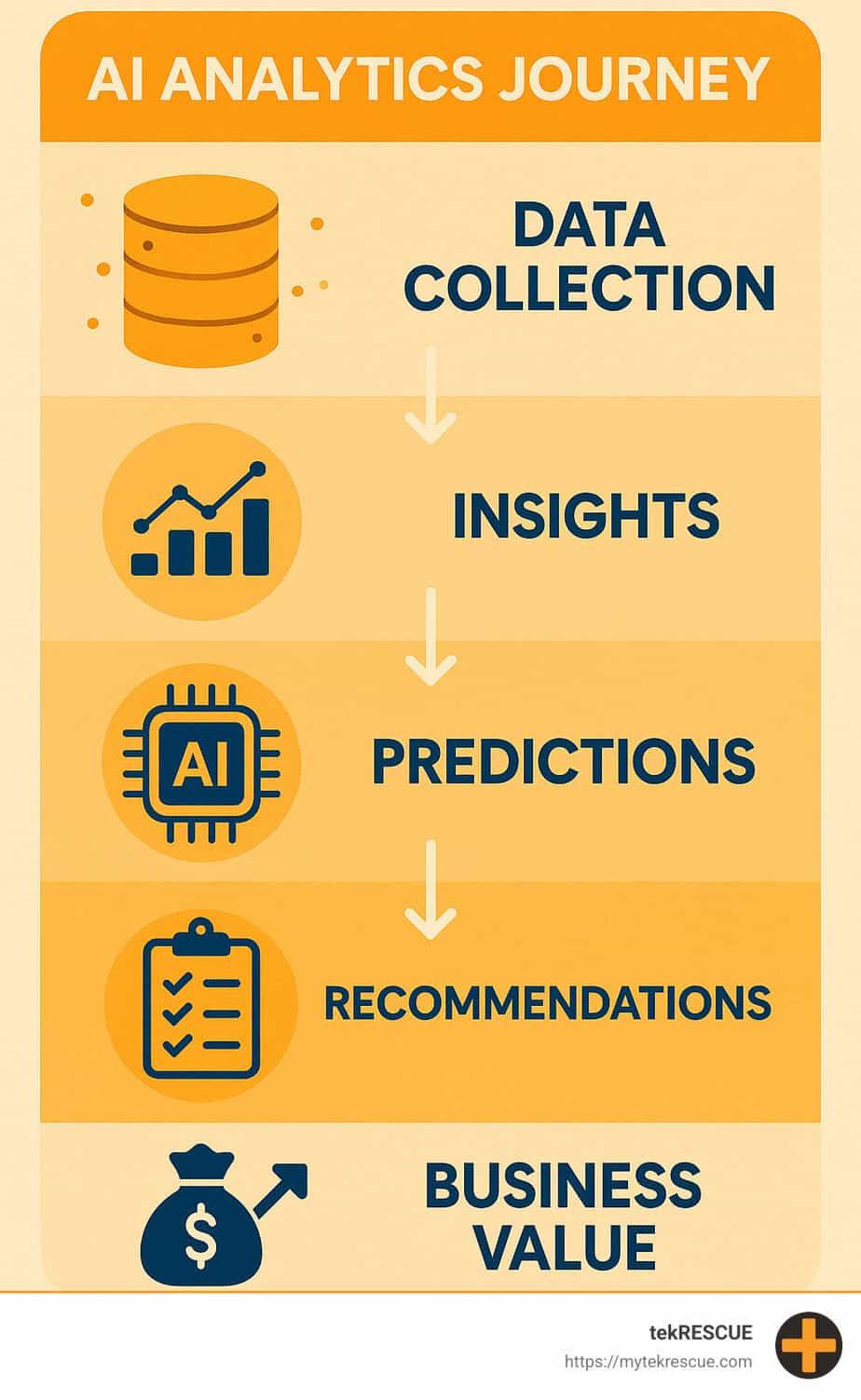
Contact tekRESCUE today to schedule a consultation and find how we can help you turn data into your most powerful business asset. Because in today’s competitive landscape, gut feelings simply aren’t enough – and AI-powered insights are the key to staying ahead of the curve.
Table of Contents

